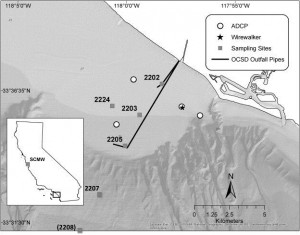A scheduled sewage release off Los Angeles provided a unique opportunity to study before and after impacts of massive nutrient injection into coastal waters. Researchers hypothesized large, potentially harmful algal blooms (HABs), would result from the discharge. The sewage release was extensively studied by NCCOS scientists, sponsored researchers, and partner agencies, and the results were not expected.

In September 2014, researchers with the California harmful algal bloom hotspots project teamed with various California agencies to study a three-week diversion of the Orange County Sanitation District effluent discharge into near-shore waters off Newport Beach (Los Angeles). The sewage discharge injected a considerable amount of secondarily-treated effluent comprised of nutrients and chlorine into the coastal ecosystem. An armada of the newest oceanographic sampling instruments (e.g., Environmental Sample Processors, robotic gliders, surface Wave Gliders and wirewalkers attached to profiling moorings, and bottom-mounted Acoustic Doppler Current Profilers) were used to study the impacts of the effluent release.
A study of the response of phytoplankton and bacterial growth during the waste-water effluent diversion found that phytoplankton abundance during and after the event did not even reach amounts associated with minor blooms typical of the region. It was possible bacteria consumed most of nutrients, limiting the phytoplankton, while zooplankton grazers feasted on the bacteria and smaller phytoplankton. Enriched effluent chlorination may also have suppressed an algal bloom, as f ield and lab studies show that sewage disinfection by chlorination creates chemical byproducts that inhibit phytoplankton growth.
As for the behavior of the wastewater plume, its position in, and dispersion within the water column, scientists found the special design of the outfall pipe diffuser created complex patterns of mixing and dilution, perhaps limiting the overall response of the phytoplankton.
These and additional research papers from the study will be pooled and published in an upcoming special issue of Estuarine, Coastal and Shelf Science.
For more information, contact Quay.Dortch@noaa.gov.
